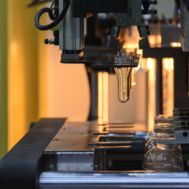
Industries

Applications

Cookie Consent
Cookies are used for statistical purposes and to improve the site.
Cookies will be used after you click "Accept" or if you continue using Dynisco.com
To find out more please review our Privacy Policy.
Gain an understanding about the selection of capillary rheometer dies that Dynisco produces for various applications. Learn More
By Azadeh Farahanchi, Rheological Scientist, Ph.D
05.21.18
Nowadays, composites are ubiquitous in many parts of modern societies such as constructions, textiles, nonwovens, and automobile industry. In composites, interface plays a pivotal role in final mechanical properties. Learn More
By Roozbeh Hajiraissi
03.02.18
Polyethylene terephthalate (PET) is a hygroscopic resin from the polyester family which absorbs moisture onto their molecular structure when they are exposed to the ambient air. This has a huge effect on the flow behavior and rheological parameters of the plastic melt. Learn More
By Azadeh Farahanchi
01.14.19
A thermal stability test can determine the resistance of a polymer melt to a change in the molecular structure at the test temperatures. The results of this test depend on the temperature, residence time at that temperature, material formulation, presence of moisture and/or contaminates Learn More
By Azadeh Farahanchi, Rheological Scientist, Ph.D
09.09.19
In this article we explain the importance of a stable MFI and how this can be done automatically. Learn More
By Dynisco and Rokoma
11.09.22
Material analysis solutions range from the analysis of a polymer in the laboratory, to online quality control in production, to processing small quantities of special polymers or composites. Check out this Q & A blog to learn more about inline viscosity measurement in PET and polyolefin recycling. Learn More
By Heiker Fischer, PETplanet Insider and Johannes Lorenz
07.28.23
Extensional/elongational viscosity measurements (melt strength) are of rheological importance in any plastic stretching process for example blow molding, sheet extrusion, blown film extrusion, fiber spinning, etc. as the plastic is constantly stretching or expanding in such processes. Learn More
By Azadeh Farahanchi, Rheological Scientist, Ph.D
07.16.18
One of the key factors in any MIM process is the flow behavior of the feedstock during filling of of the mold. In order to have a defect free molding process (without jetting, short shot, sink mark, crack, etc.) with desired mechanical strength (tensile, flexural, failure stress, etc.) in the final products, understanding of the rheological properties of the binder and feedstock is necessary Learn More
By Azadeh Farahanchi, Rheological Scientist, Ph.D
03.29.19
It can be very difficult, if not impossible, to achieve complete indentification of most polymer products. However, in most cases, this is usually not needed; what is needed is the separation, or identification, of numerous molding materials whose identity has been lost, or an indication of the type of material used to create a component. Learn More
By Dynisco
03.01.18
One of the common classical assumptions in rheological analysis, particularly in polymer melt flow in capillary rheometers, is no-slip boundary condition. Read more on why is it important to understand wall slippage when using a capillary rheometer for rheological analysis? Learn More
By Azadeh Farahanchi, Rheological Scientist, Ph.D
02.01.21
Online rheometers have been used increasingly in plastics processing and recycling industry to provide continuous data stream of rheological properties and real-time information on an extrusion process. This can beneficial for controlling of in-process product quality, reducing of waste stream, and increasing of process efficiency Learn More
By Azadeh Farahanchi, Rheological Scientist, Ph.D
10.02.18
Flow curves of polymer melts (the graph of viscosity versus shear rate in the log-log scale) has two distinct behavior of Newtonian and Power law. At very low shear rates the Newtonian behavior dominates where the viscosity is independent of the shear rate and it approaches the value of η_0 which has been named as the zero-shear viscosity Learn More
By Azadeh Farahanchi, Rheological Scientist, Ph.D
11.15.19
Learn how melt flow, capillary, rotational, and online rheometers support polymer quality, processing, and performance optimization. Learn More
By Dynisco
10.09.25
In this blog our Rheological Scientist, Azadeh Farahanchi Ph.D. discusses how to understand plastic shear thinning behavior using a melt indexer Learn More
By Azadeh Farahanchi, Rheological Scientist, Ph.D
07.30.19
Who in the Lab is ready to stop cutting prep-stock samples with scissors & shears by hand? Learn More
By Jason Bradley, Regional Sales Manager
03.03.21
Method A/B is a test that can be performed in a melt flow rate tester in order to calculate the value of the polymer`s melt density at a specific temperature Learn More
By Azadeh Farahanchi, Rheological Scientist, Ph.D
07.09.19
Providing automated access to pressure and temperature readings from your extrusion line makes complete sense to any polymer transforming operation. Learn More
By Andres Blanco, Regional Sales Manager Latin America
10.27.20
Our line of Fluidized Temperature Bath’s (FTB) liquid-like properties provide fast heat transfer to immersed tooling for immediate heating and burning off tough-to- clean polymers. Learn More
By Peter Duserick: Regional Sales Manager – Eastern US & Canada
04.02.21
For melt flow rate testing above 1000g/10min, our LMI5000 and 5500 series melt flow indexers can utilize Procedure C testing with a "half-die" capillary to measure the melt flow rate of low viscosity polymers. Learn More
By Tee Teong Seng - Director of Asia-Pacific Sales
06.18.21
How to properly charge the barrel before starting a test in LCR capillary rheometer Learn More
By Azadeh Farahanchi, Rheological Scientist, Ph.D
03.04.20
Dive into the intricacies of the melt flow index (MFI), its significance in polymer science, and how Dynisco's advanced indexers optimize polymer processing. Learn More
By Dynisco Subject Matter Experts
09.14.23
Dynisco recently helped a pharmaceutical company in the characterization of their new formulation product using our LCR7000 Capillary rheometer. Continue reading to find out more.... Learn More
By Ameet Deshmukh
05.30.23
Explore the differences between viscosity and intrinsic viscosity, crucial concepts in fluid dynamics, and their impact on scientific research Learn More
By Dynisco Subject Matter Experts
08.07.23
Laboratory Mixing Extruder as Spinning Tool to Fibrillate Droplet Phase of Polymer Blend Systems
Correlation of Melt Viscosity of Polyethylene Terephthalate to Solution Intrinsic Viscosity
Characterizing Thermal Stability of Polymer Melts Using a Capillary Rheometer

38 Forge Parkway,
Franklin MA 02038
+1 508 541 9400
Pfaffenstr. 21, 74078,
Heilbronn, Germany
+49 7131 297 0
Lot 3615, Jalan SM 6/8
32040 Seri Manjung, Perak, Malaysia
+605 6884014